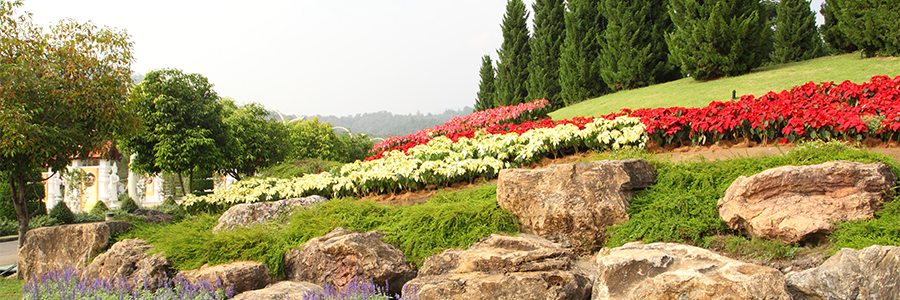
Planting a hillside with a mix of colorful perennials, shrubs, and a blooming carpet of ground cover is visually stunning. Hillside planting also prevents slope and hillside erosion by anchoring loose soils that would otherwise be swept downhill with runoff from rainfall.
Plants That Prevent Slope & Hillside Erosion
Planting ground covers is essential for preventing erosion of a slope or hillside. Mulching is an effective ground cover on slopes with less than a 33% grade. For steeper slopes, deep-rooted native grasses will prevent erosion. Terrace gardening or retaining walls are effective methods on slopes higher than a 50% grade.
Ground covers form a mat by rooting along the length of their stems, and spread down slopes and hillsides. Clumping plants such as perennials produce several stems from one root to grow outward from the center and form a compact shape. These plants also do well on slopes.
Best choices for slope and hillside planting always include native plants that thrive in drier soils. So are deep-rooted plants, such as prairie plants, ornamental grasses, shrubs, and sprawling ground cover roses. Brilliant swaths of wildflowers will always beautify a slope. For the first year or two, it is vital to weed them, and mow their stems down after they go to seed, until they establish and naturalize, to create a self-sowing garden.
No-mow grasses that can be planted on a slope or hillside include Buffalo Grasses and Fine-Leaf Fescue. A local Cooperative Extension can advise which varieties will survive in a region.
Planting just one type of plant on a slope or hillside is not recommended. A uniform landscape would only highlight any scraggly dead plants or sprouting weeds. But a mixture of different varieties of shrubs, perennials, trees and ground covers blanketing a hillside will present a most beautiful feast for the eye, while protecting the hillside from erosion. A mix of ground covers that flower at different times of the year are particularly lovely.
Plants to Avoid Growing on Slopes & Hillsides
Plants to avoid growing on a slope or hillside include those with wild growth habits that become invasive, such as Virginia Creeper, Crown Vetch, Scotch Broom, and Japanese Barberry. Again, a local Cooperative Extension can advise. Planting shallow-rooted trees on a slope or hillside is also ill-advised, due to risk of toppling.
Best Practices for Slope & Hillside Irrigation
Planting a hillside also means setting up the most efficient irrigation. Too much water will result in streaming runoff and erosion of the hillside. Not enough water, and plants cannot survive.
Drip irrigation is the most efficient method for watering a planted slope or hillside, according to Colorado State University. Whether densely planted or sparsely planted, drip irrigation works well on either slope or hillside.
Setting Up Drip Irrigation on Slopes & Hillsides
- Set up irrigation lines laterally across the slope or hillside instead of running lines up or downhill. Gravity will have less effect on the pressure in irrigation tubing.
- Make sure water source is uphill at highest elevation of slope or hillside so the system isn’t trying to work against gravity.
- Install a flush valve at the end of the line to prevent excess water from draining out of the emitters.
- To maintain a steady flow rate, use Pressure Compensating drippers.
- Dig around plants to create semicircular “watering basins” to collect water instead of letting it run downhill and taking soils with it.
Smart Irrigation on Slopes & Hillsides
Smart Irrigation will prevent too much watering that produces wasteful runoff. Baseline’s cutting edge BaseStation 3200S can measure the actual soil moisture content where it matters most—in the root zone—and use less water while optimizing plant health.
The BaseStation 3200S combines soil moisture sensor-based intelligent watering technology with cloud-based, weather-based irrigation to reduce water use up to 62 percent versus standard watering methods.
The Smart Controller learns the flow for each zone, maximizes the number of zones it can turn on at once, and helps shorten water windows.
A slope or hillside densely-planted with an explosion of textured, colorful plantings can be a landscaping showstopper to the eye. But even more important, locally acclimated native plantings paired with cutting edge, efficient irrigation will anchor slope and hillside soils with their deep, spreading roots and ground cover to prevent possibly catastrophic erosion of a hillside.

